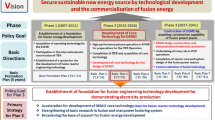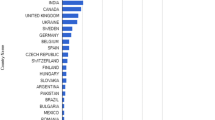Abstract
It is shown that deuterium based fusion fuels and reactors based on them face severe technological disadvantages in comparison with fission based systems as power sources for central station electric power plants. The author postulates the most plausible deuterium based fusion reactor consistent with the physics of the fusion reaction itself and compares this reactor (called “OMR-DT”) with existing fission reactors. Since neutrons are the main problem in fusion, the author suggests that a great deal more effort should be given to the study of non-Maxwellian plasmas with the emphasis on neutron-free fuel cycles. The author also suggests that the deuterium based fusion driver may play its best role as a fissile fuel producer.
Similar content being viewed by others
References
Preliminary Feasibility Assessment of Fusion-Fission Hybrids, EPRI Project No. RP-1463, WFPS; TME-81-003 (December 1980).
Energy in Transition: Final Report of the Committee on Nuclear and Alternative Energy Systems, National Academy of Sciences, Washington, D.C., 1978 (W. H. Freeman, San Francisco, 1980).
Nuclear Energy and Nuclear Weapon Proliferation, part of a conference held in Stockholm, 12–16 October 1978, under the auspices of Stockholm International Peace Research Institute (Crane, Russak, New York, 1979).
Proceedings of a Topical Meeting on The Recovery of Uranium From Sea Water, F. R. Best and M. J. Driscoll, eds., Energy Laboratory Report No. MIT-EL80-031 (December 1980).
End-Use Products of Fusion Energy: Alternatives and Their Implications to the Fusion Energy R&D Strategy, Proceedings of NSF Workshop, March 4–5 (National Science Foundation, Washington, D.C., 1982.)
Source Book of Fusion-Fission Hybrid and Related Technologies, UE&C-DOE/EPRI-781107, Electric Power Research Institute, Palo Alto, Calif. (Nov. 1978).
EPRI/DOE Fusion-Fission Review Meeting June 4, 1981, Office of Fusion Energy, U.S. Department of Energy, Germantown, Maryland (1981).
J. E. Meyer,Structural Advantages of Steady State Fusion Power Reactors, PFC/JR-78-3, Plasma Fusion Center, Mass. Inst. of Tech., Cambridge, Mass. (March 1978)
A. Cook, The feasibility of U233 breeding in deuterium-tritium devices, S. M. thesis (May, 1976).
Author information
Authors and Affiliations
Rights and permissions
About this article
Cite this article
Lidsky, L.M. End product economics and fusion research program priorities. J Fusion Energ 2, 269–292 (1982). https://doi.org/10.1007/BF01063682
Received:
Issue Date:
DOI: https://doi.org/10.1007/BF01063682




